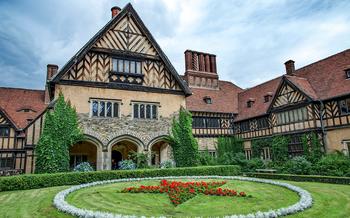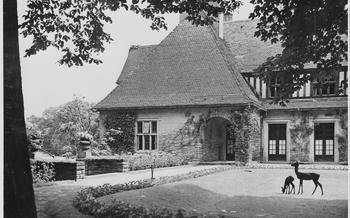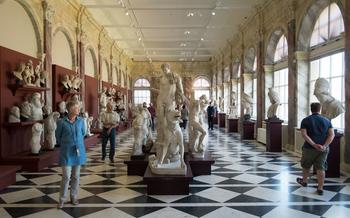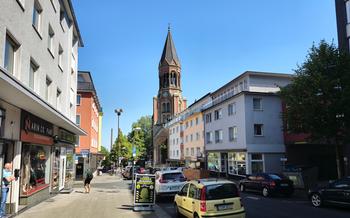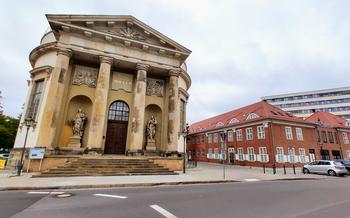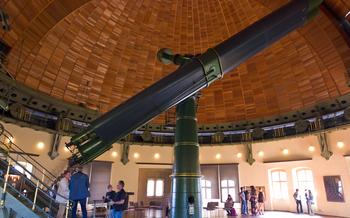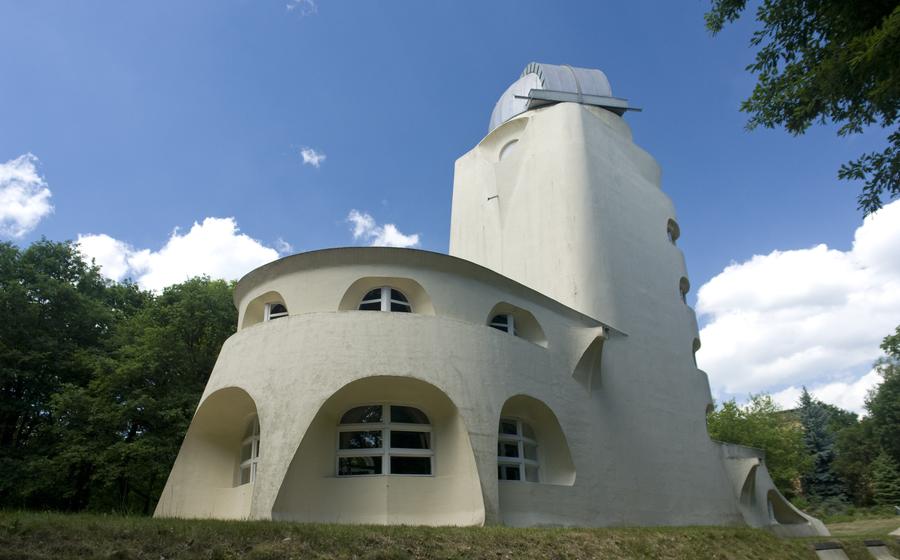
The Einstein Tower
- The Einstein Tower: A Scientific Masterpiece
- Historical Significance
- A Journey Through Time: The History of the Einstein Tower
- Exploring the Tower’s Architectural Marvel
- Einstein's Theory of Relativity: The Tower's Scientific Significance
- The Tower's Cultural Significance: A Symbol of Scientific Progress
- Visiting the Einstein Tower: Practical Information
- Exploring the Tower’s Exhibits and Displays
- Unveiling the Tower's Hidden Stories: Behind-the-Scenes Tours
- Capturing the Tower's Essence: Photography and Videography
- Engaging Educational Programs: Workshops and Lectures
- The Einstein Tower in Popular Culture: Art, Literature, and Film
- The Tower’s Legacy: Inspiring Future Generations of Scientists
- The Einstein Tower and Sustainable Tourism
- Insider Tip: Unveiling the Tower's Hidden Gems
The Einstein Tower: A Scientific Masterpiece
The Einstein Tower, a testament to scientific ingenuity and architectural brilliance, stands as a symbol of Germany's rich scientific heritage. Designed by renowned architect Erich Mendelsohn in collaboration with Albert Einstein himself, the tower was conceived as a living laboratory to test Einstein's revolutionary theory of relativity. This iconic structure, with its striking Expressionist design and innovative scientific features, has not only played a pivotal role in the advancement of scientific knowledge but has also become a cultural landmark of global significance.
Historical Significance
The Einstein Tower was built in the early 20th century, a period marked by a surge of scientific curiosity and the pursuit of understanding the universe's fundamental principles. Einstein's theory of relativity, published in 1915, challenged our understanding of space, time, and gravity. To test his groundbreaking theory, a tower was needed to provide the necessary conditions for precise astronomical observations and experiments. Thus, the Einstein Tower was born, becoming a crucial site for verifying Einstein's predictions and revolutionizing our understanding of the cosmos.
A Journey Through Time: The History of the Einstein Tower
The Einstein Tower, a beacon of scientific innovation, owes its existence to the brilliant mind of Albert Einstein and the architectural genius of Erich Mendelsohn. Their collaboration resulted in a masterpiece that transcended the boundaries of physics and architecture.
In 1917, as Einstein's theory of relativity gained momentum, the need for a dedicated facility to test its predictions became apparent. The tower's design and construction faced numerous challenges, including the outbreak of World War I and the subsequent economic turmoil.
Despite these obstacles, the tower's foundations were laid in 1920, and its construction was completed in 192The inauguration ceremony, held on October 5, 1921, marked a significant milestone in the history of science and architecture.
The tower's early years were dedicated to groundbreaking experiments aimed at verifying Einstein's theories. Scientists used the tower's telescope to observe the 1919 solar eclipse, which provided crucial evidence supporting the theory of relativity.
During World War II, the tower narrowly escaped destruction. Its unique shape and scientific significance made it a potential target for Allied bombing raids. Fortunately, the tower remained intact and resumed its scientific operations after the war.
In the decades that followed, the tower underwent several renovations and upgrades to keep pace with advancements in scientific research. It continued to be a hub of scientific discovery, contributing to our understanding of the universe and the fundamental laws that govern it.
Exploring the Tower’s Architectural Marvel
The Einstein Tower stands as a testament to the fusion of scientific precision and artistic expression. Its exterior design, a striking silhouette against the sky, exudes an aura of mystery and intrigue. The tower’s unique shape, reminiscent of a mushroom or a spaceship, is a testament to the Expressionist architectural style that was prevalent at the time of its construction. The tower’s exterior is adorned with intricate details, such as the horizontal bands of windows that encircle the building, creating a dynamic interplay of light and shadow.
The interior of the Einstein Tower is equally impressive, showcasing a functional and minimalist design that prioritizes functionality over ornamentation. The tower’s layout is characterized by its central dome, which houses the telescope, and a spiral staircase that leads to the observation platform. The use of concrete and steel in the tower’s construction not only ensured its structural integrity but also contributed to its unique aesthetic.
Among the tower’s most distinctive features is its dome, a hemispherical structure that houses the telescope. The dome’s design allows for precise positioning of the telescope and protects it from the elements. The spiral staircase, with its continuous upward movement, symbolizes the pursuit of knowledge and scientific discovery. The tower’s unique features, such as the dome, the spiral staircase, and the intricate details on the exterior, make it a masterpiece of architectural design.
Einstein's Theory of Relativity: The Tower's Scientific Significance
The Einstein Tower was constructed to test Einstein's theory of general relativity, which revolutionized our understanding of gravity and the universe. The tower's unique design allowed scientists to conduct experiments that verified Einstein's predictions about the bending of light due to gravity. This was achieved by observing the position of stars during a solar eclipse in 1919, which confirmed Einstein's theory and brought him worldwide fame. The tower has also contributed to the study of gravitational redshift, which is the change in the wavelength of light due to gravity. Ongoing research at the tower continues to explore various aspects of Einstein's theory and its implications for our understanding of the cosmos.
The Tower's Cultural Significance: A Symbol of Scientific Progress
The Einstein Tower holds immense cultural significance as an iconic representation of scientific innovation and technological advancement. Its striking architecture and unique design have made it a symbol of scientific progress and a testament to human ingenuity. The tower's enduring legacy as a center for scientific research and experimentation has cemented its status as a cultural landmark of global importance.
Recognizing its exceptional value, the United Nations Educational, Scientific and Cultural Organization (UNESCO) designated the Einstein Tower as a World Heritage Site in 199This prestigious designation highlights the tower's outstanding universal value and its contribution to the advancement of science and culture. The tower's inclusion on the World Heritage List places it among the most significant cultural and historical sites in the world, attracting visitors from around the globe who seek to experience its unique blend of scientific achievement and architectural marvel.
Beyond its scientific significance, the Einstein Tower has captured the public's imagination and become a popular tourist destination. Its distinctive appearance and association with one of the most influential scientists of all time have made it a must-see attraction for those interested in science, history, and architecture. The tower's enduring appeal lies in its ability to inspire and fascinate visitors of all ages, showcasing the power of scientific inquiry and the boundless possibilities of human knowledge.
Visiting the Einstein Tower: Practical Information
The Einstein Tower welcomes visitors eager to delve into its scientific history and architectural marvels. Conveniently located at Telegraphenberg 1 in Potsdam, Germany, the tower is easily accessible by various means of transportation. If traveling by car, ample parking spaces are available nearby.
The tower's doors are open to the public from Tuesday to Sunday, allowing visitors to explore its wonders during regular hours. Opening hours may vary seasonally, so it's advisable to check the official website or contact the tower directly for the most up-to-date information.
Admission fees are charged to help maintain and preserve this iconic landmark. Adult tickets typically range from 6 to 8 euros, while discounted rates are available for students, seniors, and families. Keep an eye out for special offers or promotions that may offer further savings.
Guided tours are an excellent way to enrich your visit, providing insightful commentary and anecdotes about the tower's history, architecture, and scientific significance. These tours are typically offered at specific times throughout the day and can be booked in advance or upon arrival.
Whether you prefer to explore at your own pace or join a guided tour, the Einstein Tower promises a captivating journey into the world of science and innovation.
Exploring the Tower’s Exhibits and Displays
The Einstein Tower houses a variety of permanent and temporary exhibits that delve into Einstein's life, work, and the history of the tower itself. Permanent exhibits showcaseEinstein's groundbreaking theories, his personal belongings, and replicas of his experiments. Visitors can also learn about the construction and scientific significance of the tower through interactive displays and multimedia presentations.
Temporary exhibits at the tower focus on various scientific topics and related themes. These exhibits often feature cutting-edge research, innovative technologies, and the work of contemporary scientists. Interactive displays and hands-on activities make these exhibits engaging and accessible to visitors of all ages.
The Einstein Tower strives to provide a comprehensive and immersive experience for visitors. Through its exhibits and displays, the tower not only educates and informs but also inspires awe and wonder in the minds of those who visit.
Unveiling the Tower's Hidden Stories: Behind-the-Scenes Tours
Beyond the public exhibits and displays, the Einstein Tower offers visitors a unique opportunity to explore its hidden stories and secrets through behind-the-scenes tours. These tours provide exclusive access to restricted areas of the tower, allowing visitors to delve deeper into its history, scientific research, and cultural significance.
Participants in these tours will gain insights into the groundbreaking experiments conducted at the tower, the challenges faced by scientists in their pursuit of knowledge, and the personal experiences of those who have worked within its walls. Guides will share anecdotes and stories that bring the tower's past to life, shedding light on the human side of scientific discovery.
Visitors will have the chance to explore the tower's control room, where the telescope is operated, and learn about the cutting-edge technology used for astronomical observations. They will also visit the tower's library, which houses a collection of rare books and manuscripts related to Einstein's work and the history of astronomy.
These behind-the-scenes tours offer a unique and immersive experience for those who want to go beyond the surface and discover the hidden depths of the Einstein Tower. They provide a glimpse into the world of scientific research and the dedication of those who push the boundaries of human knowledge.
Capturing the Tower's Essence: Photography and Videography
The Einstein Tower, with its striking silhouette and picturesque surroundings, offers a wealth of photo opportunities for visitors. Whether you're an amateur photographer or a seasoned professional, the tower's unique architecture and stunning vistas are sure to inspire your creativity.
Capture the tower's majestic form against the backdrop of a clear blue sky, or add a touch of drama with a shot during a stormy sunset. Experiment with different angles and perspectives to showcase the tower's distinctive features, such as its curved dome or spiral staircase.
For videographers, the Einstein Tower provides an ideal setting for capturing captivating footage. Whether you're creating a documentary, a short film, or simply capturing memories of your visit, the tower's unique visual elements will add depth and interest to your work.
Follow the tower's social media channels for inspiration and tips on capturing the best shots. Share your photos and videos using the designated hashtags to connect with other visitors and showcase your unique perspective of the Einstein Tower.
Organize photography and videography competitions or exhibitions to celebrate the tower's beauty and encourage visitors to share their creativity. These events provide a platform for talented photographers and videographers to showcase their work and inspire others to explore the world of visual storytelling.
Engaging Educational Programs: Workshops and Lectures
The Einstein Tower offers a range of educational programs, workshops, and seminars designed to engage visitors of all ages and backgrounds in the fascinating world of science. These programs are led by experienced educators, scientists, and researchers who share their knowledge and expertise in an accessible and engaging manner.
Workshops and seminars cover a wide range of topics, including astronomy, physics, cosmology, and the history of science. Participants have the opportunity to delve into the mysteries of the universe, explore the latest scientific discoveries, and gain a deeper understanding of the fundamental principles that govern our world.
The tower also hosts guest speakers, including renowned scientists, historians, and experts, who deliver lectures and presentations on cutting-edge research, groundbreaking theories, and the lives and work of influential figures in the scientific community.
Educational programs at the Einstein Tower are tailored to different audiences, from school children and families to university students and lifelong learners. School groups can benefit from guided tours, interactive activities, and educational materials specifically designed to complement their classroom studies.
Summer camps are another popular offering, providing children and teenagers with hands-on science experiences, outdoor activities, and the opportunity to learn from experts in a fun and engaging environment.
Through its educational programs, the Einstein Tower aims to inspire future generations of scientists, foster scientific literacy, and promote a deeper appreciation for the wonders of the universe.
The Einstein Tower in Popular Culture: Art, Literature, and Film
The Einstein Tower's distinctive silhouette and its association with scientific discovery have made it a captivating subject for artistic and cultural expression. In the realm of art, the tower has been immortalized in paintings, sculptures, and other works of art that capture its unique form and its significance as a symbol of scientific progress.
In literature, the tower has made its way into novels, poems, and short stories, serving as a backdrop for tales of scientific exploration, human ambition, and the quest for knowledge. Authors have woven the tower into their narratives, using it as a symbol of scientific achievement, a source of inspiration, or a setting for dramatic events.
The tower's striking appearance has also made it a popular choice for filmmakers. The tower has been featured in movies and documentaries that explore scientific themes or tell stories set against the backdrop of the tower's unique architecture. Its iconic status has made it a recognizable landmark in popular culture, representing the intersection of science, art, and human imagination.
The Tower’s Legacy: Inspiring Future Generations of Scientists
The Einstein Tower has played a pivotal role in inspiring future generations of scientists. The tower's scientists and researchers serve as role models for young people who are passionate about science and eager to make their own contributions to the field. The tower's educational programs and initiatives are specifically designed to promote STEM education and foster scientific curiosity among young learners. Through workshops, seminars, and interactive activities, the tower provides a platform for students to engage with hands-on science experiences and learn from experts in various scientific disciplines.
Moreover, the tower's involvement in community outreach programs and events plays a crucial role in engaging the public with science and showcasing the importance of scientific research. By organizing science fairs, hosting guest speakers, and participating in community events, the tower helps to demystify science and make it more accessible to people of all ages and backgrounds. This commitment to public engagement fosters a supportive and collaborative scientific community, where individuals can come together to share ideas, learn from one another, and work towards common scientific goals.
The Einstein Tower and Sustainable Tourism
The Einstein Tower is committed to sustainability and responsible tourism practices. The tower's management has implemented various green initiatives to reduce its environmental impact and promote eco-friendly practices. These initiatives include:
-
Energy Efficiency: The tower uses energy-efficient lighting, heating, and cooling systems to minimize energy consumption.
-
Responsible Waste Management: The tower has a comprehensive waste management program in place, including recycling, composting, and reducing single-use plastics.
-
Eco-Friendly Transportation: The tower encourages visitors to use public transportation, cycling, or walking to reach the site. Bicycle racks are available for visitors' convenience.
-
Sustainable Souvenirs: The tower offers a range of eco-friendly souvenirs and merchandise made from recycled or sustainable materials.
-
Education and Awareness: The tower's educational programs and exhibits include a focus on sustainability and responsible tourism practices, raising awareness among visitors about the importance of protecting the environment.
By embracing sustainable practices, the Einstein Tower demonstrates its commitment to preserving the environment and promoting responsible tourism.
Insider Tip: Unveiling the Tower's Hidden Gems
Beyond the tower's iconic exterior and well-known exhibits, there are hidden gems waiting to be discovered by curious visitors. One secret spot is the tower's rooftop terrace, which offers panoramic views of Potsdam and the surrounding landscape. This vantage point is particularly stunning during sunset, when the sky transforms into a vibrant tapestry of colors.
The tower also hosts special events and workshops throughout the year, providing unique opportunities for visitors to delve deeper into the world of science and astronomy. Stargazing nights are a popular event, allowing visitors to observe the cosmos through the tower's powerful telescope and learn about the wonders of the universe.
For those seeking local recommendations, the tower's staff and local residents are happy to share their favorite spots in Potsdam. From cozy cafes to hidden gardens, there are plenty of hidden gems to explore in the surrounding area.
Venturing off the beaten path, visitors can discover lesser-known places that offer a glimpse into Potsdam's rich history and culture. The nearby Cecilienhof Palace, for example, is a beautiful example of German Renaissance architecture and was once the summer residence of the German Crown Prince Wilhelm.
Exploring the hidden gems of the Einstein Tower and its surroundings is a rewarding experience that allows visitors to uncover the tower's secrets, connect with the local community, and create lasting memories.

